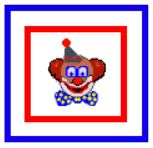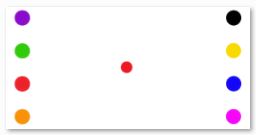Tracking: Central-Peripheral Integration
Saccadic eye movements are the jumps our eyes make as they change targets. Saccadic eye movements are controlled by two important systems that must work in perfect unison. Our central visual system fixates on the target providing a clear image. At the same time, our peripheral or side vision locates the next target to tell our eyes where to move. During reading, this simultaneous integration allows our eyes to move quickly and efficiently along the line of print as we process words without loss of place.

.
Central-Peripheral Integration: The following exercises are designed to help improve central-peripheral performance.
 Click on the link to go to this exercise. Peripheral Clown
Click on the link to go to this exercise. Peripheral Clown- Fix your eyes on the clown’s face.
- Do not move your eye off the clown, but as you stare at his face, follow the edges of the red and blue boxes with your side vision as they move outward.
- Work on “seeing” the clown’s face and the outside edge of the boxes at the same time.
- Parents: If your child has trouble maintaining fixation on the clowns face with both eyes, try having him/her cover one eye. Does this improve his/her ability to perform the task? If so, continue to work this activity with one eye at a time until performance improves; then work both eyes.
The following activity adds an eye-hand element to the visual demand (i.e., fine motor integration). Twenty percent of the raw visual data coming off the retina does not go back to the visual cortex for imaging but breaks away and travels up to the brain’s motor centers to help with balance, coordination, and movement. Visual motor integration, commonly called eye-body or eye-hand coordination, is a critical component of vision. Think of it as a visual “follow the leader”: the eyes go first and tell our muscles where to follow.
PART I
 Click on the link to go to this exercise. Peripheral Circle, slow
Click on the link to go to this exercise. Peripheral Circle, slow- Watch the circle in the center; do not look away.
- As you stare at the center circle, try to see the outside circles on the side of the screen at the same time. This is called “opening” your periphery, or side vision.
- As the center circle changes color, touch the same colored circle on the outside–without looking away from the center circle. Remember to hold your head still.
- Click on the link to go to this exercise. Peripheral Circles, fast
- This time the color of the center circle will change more quickly. Repeat the procedures as above.
- Bring It Home: Add an auditory component by saying the color of the center circle.
PART I
 Click on the link to go to this exercise. Puppy Peripheral Exercise
Click on the link to go to this exercise. Puppy Peripheral Exercise- Sit at a distance of 16 inches directly in front of the monitor and stare directly at the puppy.
- Without moving your head or eyes, look at the puppy while finding the numbers in order (1-18) using your side vision.
- If the task is too hard at first, move backwards a little until you can accomplish the task. Remember to “open” your side vision.
PART II
- Alternate Activity, Real Space. Download and print off the Puppy Peripheral chart. Puppy Peripheral Chart
- Place the chart on the wall at eye level. Stand 16 inches away.
- Repeat the activity as above in real space. Do not move your head or eyes. Look directly at the puppy while finding the numbers using only your side vision.
- Helpful Hint for Parents: Tape the charts to a full-length wall mirror. As the child completes the activity, you can monitor eye movement from behind by looking in the mirror.
